City of Sundbyberg
Sundbybergs stad | |
|---|---|
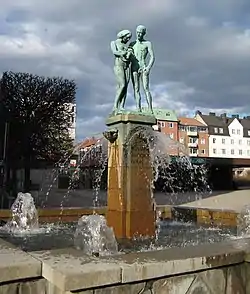 Fountain on Sundbybergs torg (square) in Central Sundbyberg | |
 Coat of arms | |
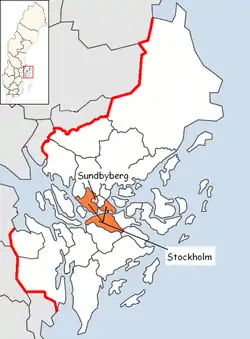 | |
| Coordinates: 59°22′N 17°58′E / 59.367°N 17.967°E | |
| Country | Sweden |
| County | Stockholm County |
| Seat | Hallonbergen, part of Stockholm |
| Area | |
| • Total | 8.77 km2 (3.39 sq mi) |
| • Land | 8.67 km2 (3.35 sq mi) |
| • Water | 0.1 km2 (0.04 sq mi) |
| Area as of 1 January 2014. | |
| Population (31 December 2021)[2] | |
| • Total | 53,564 |
| • Density | 6,100/km2 (16,000/sq mi) |
| Demonyms |
|
| Time zone | UTC+1 (CET) |
| • Summer (DST) | UTC+2 (CEST) |
| ISO 3166 code | SE |
| Province | Uppland |
| Municipal code | 0183 |
| Website | www.sundbyberg.se |
| Density is calculated using land area only. | |
Sundbyberg Municipality (Sundbybergs kommun or Sundbybergs stad) is a municipality in Stockholm County in east central Sweden, just north of the capital Stockholm. Sundbyberg is wholly within the Stockholm urban area and has a 100% urban population.
Sundbyberg was detached from Bromma (which since 1916 is in Stockholm Municipality) in 1888 as a market town (köping). It got the title of a city in 1927. In 1949 parts of Solna Municipality and Spånga Municipality (when the rest of Spånga was amalgamated into Stockholm) were added. A proposed merger with Solna in 1971 was never implemented, making Sundbyberg, with an area of 8.83 square kilometres (3.41 sq mi), the smallest municipality in Sweden, but also the most densely populated. The municipality prefers to call itself a city, which, however, has no legal significance.
History
Sundbyberg was for a long time only an area of small agriculture value and most of all used as a place to spend summer for rich families in the city. In 1863 almost the entire area was bought by Anders Petter Löfström, including Duvbo Estate, who began building houses there. In 1870 the first industrial plot was sold and from there the town did expand with railroad, houses, industries and community services of all kind. A. P. Löfström also donated to the municipality, all land for roads, streets, parks, school, church and other public areas.
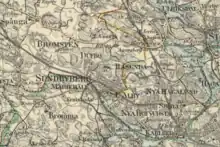
In 1888 Sundbyberg municipality was formed with 1,133 inhabitants,[3] splitting off from Bromma. At the time the municipality only constituted Central Sundbyberg and the undeveloped Storskogen. Sundbyberg was known in its early years for its beer, its spirited political discourses, its muddy streets, and the danger of the streets at night[4] (nowadays the crime-hit areas are Hallonbergen and Rissne instead[5]). Sales of land was aimed at workers and industry, and the relative lack of public services caused a strong cooperative spirit to form.[6] Suburbs bordering Sundbyberg were also built – Lilla Alby and Mariehäll in the 1880s and Duvbo around 1900. While trains stopped in Sundbyberg, they did so at a low frequency, and most commuters used the steam boat.[6] In 1910 a tram line was built from Stockholm and Råsunda to the municipal border, and then into Sundbyberg in 1928, running until 1959.[3]
A new city plan was established in 1941, prescribing the construction of lamellhus, rectangular multi-residential buildings with typically four floors, leading to the demolishment of most of the wooden houses in Sundbyberg in the 1940s, while brick or concrete buildings were kept. Many industrial buildings were converted to residential use at the same time. Rising housing prices led to a more densely built suburb than envisioned in the city plan,[7] as well as cause Sundbyberg to rapidly lose its industrial character.[6]
In 1946 Sundbyberg municipality, which by then had 15,000 inhabitants, bought Storskogen, with the first homes going up there in 1952. In 1949 Spånga municipality was split between neighbouring municipalities, giving Duvbo, Ursvik and some other land to Sundbyberg. Lilla Alby was transferred from Solna municipality to Sundbyberg at the same time.[3] Since the 1950s when Storskogen was built, Sundbyberg has expanded one district each decade, with Ör built in the 1960s, Hallonbergen and its metro line (which also serves Storskogen and Ör) in the 1970s, Rissne and its metro line (which also serves Central Sundbyberg and Lilla Alby) in the 1980s, Brotorp and Stora Ursvik in the 2000s.[4][8]
Economy
The roughly 50,000 inhabitants live in about 20,000 households. The industrial policy of the municipality is to provide one job opportunity for every household, with there being around 23,000 jobs in the municipality (in 2015[9][10]). So unlike other municipalities in Metropolitan Stockholm, Sundbyberg is not a bedroom suburb wherefrom people commute to Stockholm, but also a place commuted to from outside. In total, 19,000 commuters travel in each direction to or from Sundbyberg every day (in 2014).[9] The unemployment rate in Sundbyberg closely tracks the average for Stockholm County[11] and is generally lower than the Swedish average.[12]
In the first half of its existence, Sundbyberg saw a strong expansion of industrial activity, and most residents were industrial workers, but in the 1940s the industry almost entirely disappeared from Sundbyberg. By the 1970s warehouses and IT businesses had established themselves instead, and an attempt to establish industry in Hallonbergen had failed due to high rental costs.[6] Today the service sector dominates, with Sundbyberg having become a place with office workers, as a result of Sundbyberg becoming more central as Stockholm has expanded and public transport has been strengthened.[4] The most common professions for people working in Sundbyberg are (in order from most employed): IT developer, banker, human relations, secretary, business seller/purchaser, accountant, retail clerk, truck/bus driver, teacher, tax collector.[9] There are office districts in Central Sundbyberg (Sundbyberg centrum and Allén), Rissne (Ursviks Entré) and Hallonbergen (Sundby Park). In 2015 Sundbyberg centrum offices had rents (2,100 kr/m2/year) similar to Kista, Alvik and the adjacent Solna Business Park, while in Allén they a bit lower and similar to Lidingö Centrum and the nearby Solna Strand, and Ursviks Entré and Sundby Park both have further lower office rents similar to Farsta and Tyresö Centrum.[13]
Unusually for Stockholm suburbs, Sundbyberg has a proper town centre,[14] with plenty of nice shops in the Central Sundbyberg area, which makes the little city a bit independent. There are also smaller concentrations of stores elsewhere in the municipality, such as by the Rissne and Hallonbergen metro stations.[15] The proximity of the shopping centres Bromma Blocks (1 km away) and Mall of Scandinavia (2 km away) has hindered establishment of a shopping centre in Central Sundbyberg.[16] Businesses in Hallonbergen suffer from getting few customers from elsewhere due to the area's poor reputation, whereas the area's locals don't mind going elsewhere, e.g. to cafés in Central Sundbyberg.[17]
Demography
Population development
| Year | Population | ||||||||
|---|---|---|---|---|---|---|---|---|---|
| 1970 | 28,085 | ||||||||
| 1975 | 26,995 | ||||||||
| 1980 | 25,717 | ||||||||
| 1985 | 28,516 | ||||||||
| 1990 | 31,308 | ||||||||
| 1995 | 31,803 | ||||||||
| 2000 | 33,868 | ||||||||
| 2005 | 34,016 | ||||||||
| 2010 | 38,633 | ||||||||
| 2015 | 46,110 | ||||||||
| 2019 | 52,414 | ||||||||
| 2020 | 52,669 | ||||||||
|
Source: SCB - Folkmängd efter region och år and SCB - Folkmängd i riket, län och kommuner 30 september 2020 och befolkningsförändringar 1 juli - 30 september 2020. Totalt. | |||||||||
2022 by district
This is a demographic table based on Sundbyberg Municipality's electoral districts in the 2022 Swedish general election sourced from SVT's election platform, in turn taken from SCB official statistics.[18]
Residents include everyone registered as living in the district, regardless of age or citizenship status. Valid voters indicate Swedish citizens above the age of 18 who therefore can vote in general elections. Left vote and right vote indicate the result between the two major blocs in said district in the 2022 general election. Employment indicates the share of people between the ages of 20 and 64 who are working taxpayers. Foreign background is defined as residents either born abroad or with two parents born outside of Sweden. Median income is the received monthly income through either employment, capital gains or social grants for the median adult above 20, also including pensioners in Swedish kronor. The section about college graduates indicates any degree accumulated after high school.
In total there were 53,431 residents, including 38,222 Swedish citizens of voting age.[18] 56.1 % voted for the left coalition and 42.2 % for the right coalition.
| Location | Residents | Valid voters | Left vote | Right vote | Employed | SV parents | 1st/2nd gen | Income | College |
|---|---|---|---|---|---|---|---|---|---|
| % | % | % | % | % | % | ||||
| Brotorp/Kymlinge | 2,188 | 1,299 | 53.3 | 45.9 | 88 | 64 | 36 | 38,888 | 74 |
| Centrala Sbg 1 | 2,081 | 1,715 | 52.8 | 46.3 | 86 | 67 | 33 | 34,739 | 64 |
| Centrala Sbg 2 | 1,420 | 1,213 | 51.1 | 48.0 | 85 | 75 | 25 | 31,602 | 57 |
| Centrala Sbg 3 | 1,623 | 1,307 | 54.1 | 44.7 | 83 | 72 | 28 | 31,409 | 57 |
| Centrala Sbg 4 | 1,203 | 1,014 | 54.2 | 44.7 | 85 | 75 | 25 | 31,330 | 61 |
| Centrala Sbg 5 | 1,744 | 1,440 | 55.8 | 43.1 | 85 | 76 | 24 | 33,013 | 64 |
| Centrala Sbg 6 | 1,676 | 1,345 | 54.7 | 44.3 | 86 | 77 | 23 | 32,902 | 59 |
| Centrala Sbg 7 | 1,296 | 1,051 | 54.0 | 44.7 | 83 | 73 | 27 | 30,722 | 63 |
| Duvbo 1 | 1,435 | 1,061 | 50.0 | 48.9 | 83 | 75 | 25 | 33,582 | 59 |
| Duvbo 2 | 1,439 | 1,059 | 45.6 | 54.1 | 84 | 79 | 21 | 37,112 | 69 |
| Hallonbergen 1 | 2,472 | 1,503 | 63.5 | 33.5 | 70 | 22 | 78 | 21,480 | 42 |
| Hallonbergen 2 | 2,011 | 1,138 | 67.3 | 28.7 | 63 | 19 | 81 | 18,314 | 34 |
| Hallonbergen 3 | 1,700 | 1,091 | 68.2 | 28.9 | 68 | 19 | 81 | 19,235 | 35 |
| Lilla Alby 1 | 1,949 | 1,532 | 53.9 | 44.5 | 85 | 72 | 28 | 31,456 | 57 |
| Lilla Alby 2 | 1,991 | 1,559 | 54.8 | 44.0 | 84 | 70 | 30 | 33,106 | 60 |
| Lilla Alby 3 | 1,462 | 1,226 | 48.5 | 51.0 | 89 | 81 | 19 | 39,377 | 68 |
| Lilla Alby 4 | 1,755 | 1,404 | 52.6 | 46.1 | 85 | 68 | 32 | 34,680 | 62 |
| Lilla Ursvik | 1,077 | 738 | 48.9 | 50.3 | 85 | 73 | 27 | 36,365 | 63 |
| Rissne 1 | 2,428 | 1,536 | 60.0 | 36.4 | 77 | 41 | 59 | 26,343 | 45 |
| Rissne 2 | 2,393 | 1,666 | 64.5 | 32.8 | 75 | 36 | 64 | 24,882 | 43 |
| Rissne 3 | 1,866 | 1,150 | 66.0 | 32.6 | 71 | 27 | 73 | 24,263 | 48 |
| Rissne 4 | 1,836 | 1,268 | 67.0 | 30.1 | 72 | 37 | 63 | 23,795 | 35 |
| Stora Ursvik 1 | 1,688 | 977 | 50.2 | 47.8 | 87 | 68 | 32 | 39,810 | 74 |
| Stora Ursvik 2 | 1,771 | 1,089 | 60.5 | 37.5 | 84 | 37 | 63 | 31,254 | 61 |
| Stora Ursvik 3 | 1,638 | 1,002 | 59.5 | 36.8 | 80 | 39 | 61 | 27,666 | 47 |
| Stora Ursvik 4 | 2,152 | 1,401 | 59.2 | 39.5 | 86 | 48 | 52 | 33,753 | 66 |
| Storskogen 1 | 1,574 | 1,371 | 57.9 | 40.2 | 76 | 68 | 32 | 24,384 | 43 |
| Storskogen 2 | 1,564 | 1,230 | 53.8 | 44.8 | 83 | 63 | 37 | 31,041 | 58 |
| Tulemarken | 1,675 | 1,298 | 54.0 | 44.9 | 86 | 76 | 24 | 34,892 | 64 |
| Ör | 2,324 | 1,539 | 59.7 | 37.9 | 77 | 47 | 53 | 24,379 | 43 |
| Source: SVT[18] | |||||||||
Residents with a foreign background
On 31 December 2017 the number of people with a foreign background (persons born outside of Sweden or with two parents born outside of Sweden) was 20 229, or 40.93% of the population (49 424 on 31 December 2017). On 31 December 2002 the number of residents with a foreign background was (per the same definition) 8 531, or 25.24% of the population (33 797 on 31 December 2002).[19] On 31 December 2017 there were 49 424 residents in Sundbyberg, of which 14 954 people (30.26%) were born in a country other than Sweden. Divided by country in the table below - the Nordic countries as well as the 12 most common countries of birth outside of Sweden for Swedish residents have been included, with other countries of birth bundled together by continent by Statistics Sweden.[20]
| Country of birth[20] | ||
|---|---|---|
| 31 December 2017 | ||
| 1 | 34,470 | |
| 2 | Asia: Other countries | 2,002 |
| 3 | 1,770 | |
| 4 | 1,394 | |
| 5 | Africa: Other countries | 1,393 |
| 6 | 1,270 | |
| 7 | 1,047 | |
| 8 | 992 | |
| 9 | 842 | |
| 10 | 745 | |
| 11 | South America | 665 |
| 12 | Europe outside of the EU: other countries | 586 |
| 13 | 333 | |
| 14 | North America | 286 |
| 15 | 267 | |
| 16 | 263 | |
| 17 | 213 | |
| 18 | 211 | |
| 19 | 165 | |
| 20 | 163 | |
| 21 | 138 | |
| 22 | 77 | |
| 23 | 51 | |
| 24 | Oceania | 39 |
| 25 | 38 | |
| 26 | Unknown country of birth | 4 |
By district
| District | Population 2020[21] | New homes planned 2021-2034[21] | Housing tenure 2018 rental/coop/house[22] | Higher education of 20-64yo 2018[23] | Foreign born 2010 [24] | Sickness days/year 2010[25] |
|---|---|---|---|---|---|---|
| Stora Ursvik | 6 706 | 4 963 | 31%/56%/14% | 59% | 20% | 15 |
| Lilla Ursvik | 1 069 | 0 | 0%/22%/78% | |||
| Brotorp/Järvastaden | 2 175 | 475 | 0%/30%/70% | |||
| Rissne | 8 601 | 1 425 | 69%/29%/2% | 37% | 50% | 30 |
| Hallonbergen | 5 984 | 3 133 | 70%/30%/0% | 30% | 67% | 38 |
| Ör | 2 298 | 846 | 47%/53%/0% | 36% | 32% | 31 |
| Duvbo | 2 212 | 0 | 35%/22%/42% | 59% | 18% | 15 |
| Central Sundbyberg | 14 585 | 1 170 | 56%/42%/1% | 54% | 20% | 22 |
| Storskogen | 3 067 | 47 | 73%/26%/1% | 43% | 21% | 29 |
| Lilla Alby | 5 946 | 230 | 56%/43%/0% | 51% | 24% | 24 |
| Other | 138 | - | Sweden: 44%[26] | Sweden: 20%[27] | Sweden: 25[28] |
Public transportation
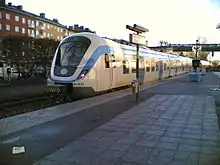
Sundbyberg is well served by the Stockholm public transport system. There are several metro stations as well as one Stockholm commuter rail station and plenty of bus routes. Even some main line trains call at Sundbyberg. The Tvärbanan light rail service was extended from Sickla Udde via Alvik to Solna centrum in October 2013. The line runs through Central Sundbyberg with tracks laid in the street and has two stops within the municipality. Construction of a northern light railway branch from Ulvsunda to Kista that will pass through Rissne and Stora Ursvik started in 2018.[29]
Districts
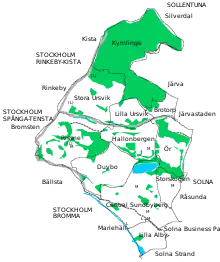
Sports
The following sports clubs are located in Sundbyberg:
Gallery
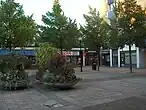 Storskogstorget, a square in Storskogen
Storskogstorget, a square in Storskogen Apartment block from 1911 in Central Sundbyberg
Apartment block from 1911 in Central Sundbyberg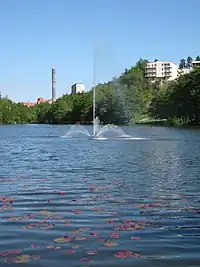 Lötsjön, a lake in the middle of Sundbyberg
Lötsjön, a lake in the middle of Sundbyberg Hallonbergen centre
Hallonbergen centre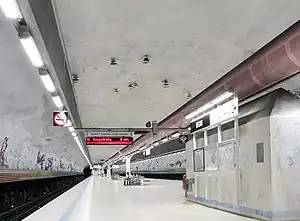 Metro station in Rissne
Metro station in Rissne Residential buildings in Stora Ursvik
Residential buildings in Stora Ursvik
References
- ↑ "Statistiska centralbyrån, Kommunarealer den 1 januari 2014" (in Swedish). Statistics Sweden. 2014-01-01. Archived from the original (Microsoft Excel) on 2016-09-27. Retrieved 2014-04-18.
- ↑ "Folkmängd i riket, län och kommuner 31 december 2021" (in Swedish). Statistics Sweden. February 22, 2022. Retrieved February 22, 2022.
- 1 2 3 "Några årtal ur stadens historia". Sundbyberg stadsmuseum. Retrieved 1 Sep 2020.
- 1 2 3 "Historia". Sundbyberg municipality. Retrieved 1 Sep 2020.
- ↑ "Kriminaliteten i Rissne och Hallonbergen har ökat". Mitt i Sundbyberg. 3 June 2019. Retrieved 1 Sep 2020.
- 1 2 3 4 "Industriminnen i Sundbyberg, 1978, Länsstyrelsen i Stockholms län". Kulturarv Stockholm. Retrieved 26 Aug 2020.
- ↑ Rolf Hammarskiöld & Hanna Hjalmarsson. "Sundbybergs bebyggelse Rapport 2016:10 Antikvariskt kunskapsunderlag" (PDF). Stockholms läns museum. Retrieved 12 Feb 2021.
- ↑ "Konsten i trafiken - Historia". Storstockholms Lokaltrafik. Retrieved 1 Sep 2020.
- 1 2 3 "Sundbyberg 2016 kommunfakta" (PDF). Sundbyberg municipality. Retrieved 17 Aug 2020.
- ↑ "Fakta om SL och länet 2018" (PDF). Storstockholms Lokaltrafik. Retrieved 17 Aug 2020.
- ↑ Ronja Mårtensson (1 Sep 2020). "Arbetslösheten ökar - lär bli värre i höst". Mitt i Sundbyberg.
- ↑ "Arbetslöshet (Arbetsförmedlingen), Sundbyberg". ekonomifakta.se. Retrieved 8 Sep 2020.
- ↑ "Projekt Enköpingsvägen Utveckling av kontor i Madendalen - analys av fyra alternativ". Sundbyberg municipality / evidens. Retrieved 11 Mar 2021.
- ↑ "Sundbyberg – växer på höjden: Sverige på gång". Ekonomikanalen EFN. Archived from the original on 2021-12-11. Retrieved 8 Sep 2020.
- ↑ "Från miljonprogram till framtidens boende". Stockholm Direkt. 3 Jan 2019. Retrieved 9 Sep 2020.
- ↑ "Två hyresgäster lämnar Signalfabriken". 3 September 2020.
- ↑ "Miljardinjektion ska bryta trend". 4 September 2018.
- 1 2 3 "Valresultat 2022 för Sundbyberg i riksdagsvalet" (in Swedish). SVT. 11 September 2022. Retrieved 13 January 2024.
- ↑ Antal personer efter region, utländsk/svensk bakgrund och år (Read 4 januari 2019)
- 1 2 Statistiska centralbyrån: Utrikes födda efter län, kommun och födelseland 31 december 2017 (XLS-fil) Läst 4 januari 2019
- 1 2 "Befolkning och demografi". Sundbyberg municipality. 27 Aug 2020. Retrieved 11 Jan 2021.
- ↑ "Översiktsplan för Sundbyberg. Sundbyberg 2030 – urbant och hållbart" (PDF). Sundbyberg municipality. Retrieved 11 Jan 2021.
- ↑ "Socialt bokslut 2018" (PDF). Sundbyberg municipality. p. 45. Retrieved 11 Jan 2021.
- ↑ "RUFS områdesdata 2010 - Sundbyberg personer med utländsk bakgrund". Stockholms läns landsting. Retrieved 11 Jan 2021.
- ↑ "RUFS områdesdata 2010 - Sundbyberg ohälsotal". Stockholms läns landsting. Retrieved 11 Jan 2021.
- ↑ "Utbildningsnivån i Sverige". Statistics Sweden (SCB). 2020-09-01. Retrieved 11 Jan 2021.
- ↑ "Utrikes födda i Sverige". Statistics Sweden (SCB). 2020-09-02. Retrieved 11 Jan 2021.
- ↑ "Ohälsotalet. Hela riket och kön. År 1997 - 2018". Statistics Sweden (SCB). Retrieved 11 Jan 2021.
- ↑ "Tvärbanan till Kista och Helenelund - Sll". www.sll.se. Retrieved 19 April 2018.
Further reading
- Sundbyberg Den nya Förstaden, H. Österberg,Sundbybergs Museum
- Sundbyberg under Köpingtiden, H. Österberg,Sundbybergs Museum
- Sundbyberg den 113:e Staden, H. Österberg,Sundbybergs Museum
- Sundbyberg i Gamla Bilder, H. Österberg, Sundbybergs Museum
- Sundbyberg bygger en Kyrka, H. Österberg, Sundbybergs Museum
- Sundbyberg - om hus och miljöer, Eva Söderlind
External links
- Sundbyberg Municipality - Official site
- Sundbyberg Museum & Archive - Official site